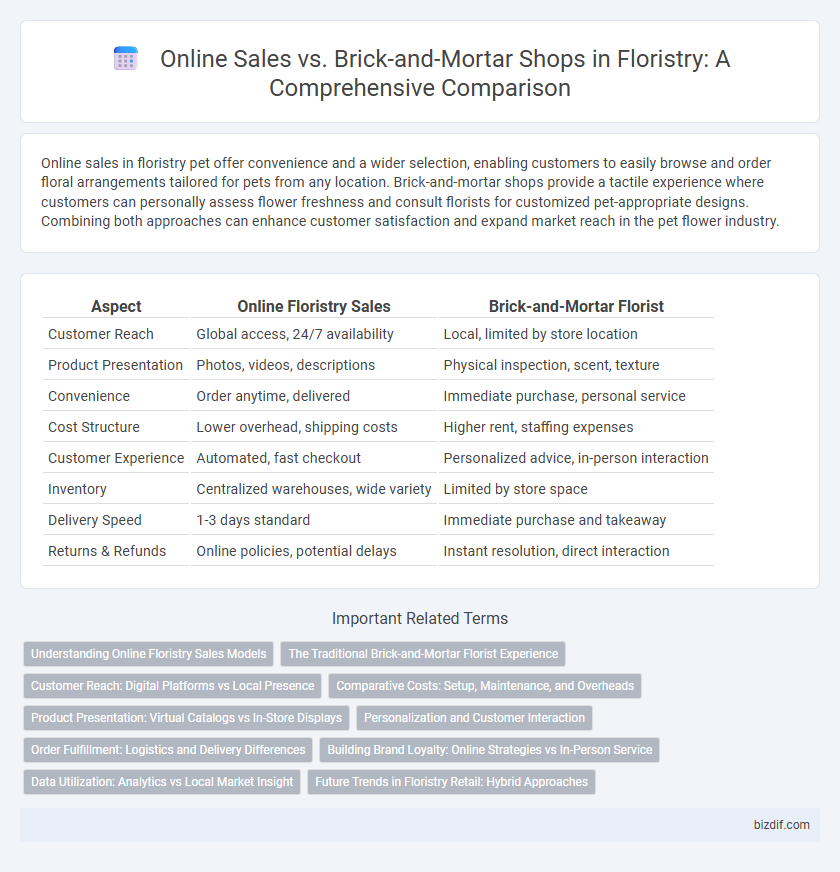Online sales in floristry pet offer convenience and a wider selection, enabling customers to easily browse and order floral arrangements tailored for pets from any location. Brick-and-mortar shops provide a tactile experience where customers can personally assess flower freshness and consult florists for customized pet-appropriate designs. Combining both approaches can enhance customer satisfaction and expand market reach in the pet flower industry.
Table of Comparison
| Aspect | Online Floristry Sales | Brick-and-Mortar Florist |
|---|---|---|
| Customer Reach | Global access, 24/7 availability | Local, limited by store location |
| Product Presentation | Photos, videos, descriptions | Physical inspection, scent, texture |
| Convenience | Order anytime, delivered | Immediate purchase, personal service |
| Cost Structure | Lower overhead, shipping costs | Higher rent, staffing expenses |
| Customer Experience | Automated, fast checkout | Personalized advice, in-person interaction |
| Inventory | Centralized warehouses, wide variety | Limited by store space |
| Delivery Speed | 1-3 days standard | Immediate purchase and takeaway |
| Returns & Refunds | Online policies, potential delays | Instant resolution, direct interaction |
Understanding Online Floristry Sales Models
Online floristry sales models predominantly include direct-to-consumer floral delivery services and subscription-based flower plans, leveraging e-commerce platforms to reach a wider audience. These models utilize data analytics and targeted marketing to personalize customer experiences, enhancing convenience and accessibility compared to traditional brick-and-mortar shops. Inventory management tools and real-time order tracking further optimize operations, enabling florists to reduce waste and improve customer satisfaction in online transactions.
The Traditional Brick-and-Mortar Florist Experience
The traditional brick-and-mortar florist offers customers the tactile experience of selecting fresh blooms and personalized arrangements in person, ensuring immediate satisfaction and custom service. Physical shops provide sensory engagement through fragrance, texture, and expert advice, creating an emotional connection often missing in online transactions. Despite the convenience of online sales, the tangible, immersive nature of visiting a local florist remains unmatched for many flower enthusiasts.
Customer Reach: Digital Platforms vs Local Presence
Online sales leverage digital platforms to expand customer reach beyond geographical boundaries, enabling florists to attract a global audience through social media, e-commerce websites, and targeted online advertising. Brick-and-mortar shops rely on local presence to build strong community relationships, fostering customer loyalty and immediate personalized service in physical locations. Combining digital strategies with a physical storefront can maximize market penetration by tapping into both broad online traffic and dedicated local clientele.
Comparative Costs: Setup, Maintenance, and Overheads
Online floristry sales require lower initial setup costs, mainly limited to website development and digital marketing, compared to brick-and-mortar shops that incur expenses for physical retail space, interior design, and utilities. Maintenance costs for online stores focus on platform updates and customer service, while traditional shops face ongoing overheads like rent, staff salaries, and inventory storage. Overall, brick-and-mortar florists experience higher fixed costs and variable overheads, whereas online florists benefit from more scalable and flexible expenditures.
Product Presentation: Virtual Catalogs vs In-Store Displays
Virtual catalogs in online floristry offer detailed images, 360-degree views, and interactive filters that enhance customer experience by allowing easy browsing and selection from a vast flower inventory. In contrast, brick-and-mortar shops rely on tactile in-store displays showcasing real bouquets, fragrances, and textures that provide sensory engagement and immediate personalization. Combining immersive virtual presentations with authentic physical displays can significantly boost customer satisfaction and sales in the floral industry.
Personalization and Customer Interaction
Personalization in floristry thrives in brick-and-mortar shops where customers can engage directly with florists to customize arrangements tailored to specific tastes and occasions. Online sales platforms leverage algorithms and data analytics to offer personalized recommendations but often lack the tactile experience that enhances emotional connection. Customer interaction in physical stores fosters trust and immediate feedback, while online channels rely on chatbots and reviews, which may limit nuanced, real-time communication.
Order Fulfillment: Logistics and Delivery Differences
Order fulfillment in floristry varies significantly between online sales and brick-and-mortar shops, with online retailers relying heavily on complex logistics networks to ensure timely delivery and maintain flower freshness. Brick-and-mortar florists manage in-person transactions and immediate customer pickups, reducing the need for extensive shipping infrastructure but limiting geographic reach. Efficient cold chain logistics and real-time tracking are critical for e-commerce florists to minimize delivery delays and preserve floral quality.
Building Brand Loyalty: Online Strategies vs In-Person Service
Building brand loyalty in floristry hinges on personalized customer experiences, where online strategies leverage targeted email marketing, loyalty apps, and social media engagement to foster repeat purchases. Brick-and-mortar shops excel through face-to-face interactions, expert floral consultations, and sensory experiences that create emotional connections and trust. Combining online convenience with in-store personal service offers a holistic approach to nurturing long-term customer relationships in the floral industry.
Data Utilization: Analytics vs Local Market Insight
Online floristry sales leverage data analytics to track consumer behavior, optimize inventory, and personalize marketing strategies based on real-time online trends and customer preferences. Brick-and-mortar shops utilize local market insights, such as seasonal demand, cultural events, and community relationships, to tailor their offerings and create personalized customer experiences. Combining analytic-driven online strategies with localized knowledge can maximize sales efficiency and customer satisfaction in the floral industry.
Future Trends in Floristry Retail: Hybrid Approaches
Hybrid approaches in floristry retail combine the convenience of online sales with the tactile experience of brick-and-mortar shops, driving future growth by meeting diverse customer preferences. Integrating augmented reality tools allows customers to visualize floral arrangements in their own spaces before purchase, enhancing the online shopping experience. Data-driven inventory management across both platforms optimizes stock levels and reduces waste, creating a more sustainable and efficient retail model.
Online sales vs Brick-and-mortar shop Infographic

 bizdif.com
bizdif.com